Rachel Barenblat's Blog, page 159
April 26, 2014
Daily April poem: a curtal sonnet
DREAM
For what endures. For old soles worn
until a toe peeks through. For hands
that press dough flat; for the griddle, hot.
For the Western Union sign behind glass,
the sparse shelves of masa and gari
give thanks. It's safe to speak in tongues.
Let all who are hungry come and eat.
Inscribe Emma Lazarus at every border.
Fire up crop dusters and drop greencards.
Trust the rains to fall. If not now --
then when?
Today's NaPoWriMo prompt invites the writing of a curtal sonnet, a form invented by Gerard Manley Hopkins in the 1800s. One of my very favorite poems is a curtal sonnet -- Hopkins' Pied Beauty, which we read every year on the first night of Pesach as part of our creative Hallel, our poems and psalms of praise. I decided not to try for rhyme, but I did try to match Hopkins' use of four stresses per line.
In the Counting of the Omer, today is the day of netzach she'b'gevurah, endurance within boundaried strength. Thinking about endurance and about boundaries led me to a few of this poem's images, and the poem grew from there. The first line of the second stanza is from the Passover seder. The final question comes from the sage Hillel.
April 25, 2014
The December Project
Some of you may have read the recent essay by Sara Davidson in the Huffington Post titled Passover Asks: Are You Ready to Go? Here's an excerpt from near the beginning of the piece:
When I arrived that morning at his home in Boulder, CO, the rabbi's wife, Eve, was in the kitchen, preparing for Passover by removing "hametz" -- anything containing flour that's risen -- from every drawer, shelf and counter. I walked down to the basement, where Reb Zalman stood up from his computer desk and greeted me with a hug.
"What does Passover feel like in the December years?" I asked, as we settled in chairs facing each other.
"That's such a good question. Give me a moment to go inside." He closed his eyes, waiting to sense what would arise. "When we come to the end of the seder, we open the door for Elijah the prophet. I ask everyone to be silent and think, 'What question would I like to ask the messenger of God?'" He said people reflect on that, sitting quietly while the door is open, and after it's closed, he asks if they'd like to share what they heard.
"Then we come to the place in the ceremony where Elijah asks, 'Are you ready to go?'"
"Go where?" I said.
"Go forth from the seder into the world. But for me it's also, 'Are you ready to go?'"
Readiness is an essential quality in the story of the Exodus: readiness to leave, to head into the unknown, to trust. Readiness is part of celebrating seder. And readiness is required if one wants to face the end of life gracefully, whenever that end may come.
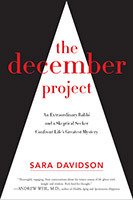 This is a story which also appears in Sara Davidson's new book The December Project, subtitled "An Extraordinary Rabbi and a Skeptical Seeker Confront Life's Greatest Mystery." The book chronicles two years' worth of regular conversations between Sara and Rabbi Zalman Schachter-Shalomi, "Reb Zalman," about navigating the December of one's life, doing spiritual end-of-life work, and approaching death with open eyes, clear heart, and untroubled mind.
This is a story which also appears in Sara Davidson's new book The December Project, subtitled "An Extraordinary Rabbi and a Skeptical Seeker Confront Life's Greatest Mystery." The book chronicles two years' worth of regular conversations between Sara and Rabbi Zalman Schachter-Shalomi, "Reb Zalman," about navigating the December of one's life, doing spiritual end-of-life work, and approaching death with open eyes, clear heart, and untroubled mind.
The resulting book is somewhere between memoir (stories of Reb Zalman's childhood, upbringing, adventures, and spiritual life) and the kind of conversation one might have over coffee with a dear friend after many years of connection, when you can go straight to the stuff that matters.
For we who are students of Reb Zalman, or students of his students, much of this material will be familiar. Many of us will have heard him tell these stories, often more than once! But that doesn't make them any less a pleasure to read, and being able to imagine his presence, his humor, and his singing voice just adds to the experience of diving into the book. And for those who haven't been blessed with a personal relationship with this rebbe, the book offers some of those gifts in printed form.
Reb Zalman's been working with these ideas for years. Some of the practices at the end of this book are similar to the exercises in his From Aging to Sage-ing, a book which I also recommend. But this book takes a different tack. And Sara Davidson, this book's author, offers an interesting path in. She is open about both her doubts and her hopes. Over the course of the book, she takes us on her journey -- not only into these conversations, but also into her mother's illness and death, and into her own anxieties about the end of life and what comes after. She strikes a keen balance between sharing enough of herself that she is a real presence in the book, and withdrawing enough of herself that we can feel that we too are sitting in intimate conversation with Reb Zalman, gleaning some of what he's harvested over nearly ninety years of life.
In one scene which has stayed with me, Sara has appeared for their regular appointment and Reb Zalman is clearly unwell, struggling with a variety of physical ailments which are dragging him down. They talk about his need to disengage even from beloved students in order to marshall his energy for his own survival. And then he tells her about how he used to maintain an open-door policy on Shabbat, where people were welcome to come and pray and sing and learn; now he spends Shabbat only with his wife. Here's how Sara describes it:
Before Friday night arrives, he writes his love-letter and slips it under her plate. On Saturday at dusk, they sit outside if the weather is mild and sing Shabbos melodies until it's totally dark. "It's so wonderful," he said, and I watched his body soften and his breathing become more relaxed. It was as if the words, like the smell of chickens roasting on Fridays at camp, had a Pavlovian effect, taking him to a Shabbos state of mind.
In telling the story of how he has come to adapt Shabbat practices for his late eighties, he models for us what it would be like to thoughtfully choose what to relinquish as we age.
Reb Zalman's sweetness, his sense of humor, and his deep hunger for God all come through in this book -- as do his idiosyncracies and some of the challenges which have resulted. Here are stories about Chabad, about meeting Howard Thurman and coming to deep ecumenism, about experiencing Christian and Buddhist mentors, even about experimenting with LSD as a path to God. He's also honest about his failings and his mistakes -- not in a self-congratulatory way, but thoughtfully. I was particularly moved by his frank and gentle words about his first marriage and its dissolution, and by the chapter where he asks to undergo taharah -- the washing / blessing / dressing of one's body after death -- in order to prepare himself for that experience when it comes.
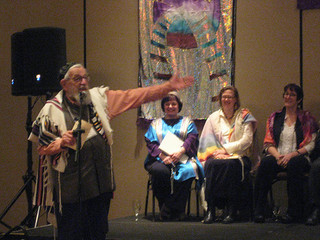 On a purely personal note, I got a particular frisson of joy while reading the chapter "You Can Take Me Now," in which Sara describes two different ALEPH ordination ceremonies. She describes Hazzan Shoshanna Brown singing a niggun which had been a favorite of the fifth Lubavitcher Rebbe, as a prelude to asking Reb Zalman to offer a teaching. Sara writes:
On a purely personal note, I got a particular frisson of joy while reading the chapter "You Can Take Me Now," in which Sara describes two different ALEPH ordination ceremonies. She describes Hazzan Shoshanna Brown singing a niggun which had been a favorite of the fifth Lubavitcher Rebbe, as a prelude to asking Reb Zalman to offer a teaching. Sara writes:
With high color in his face, Reb Zalman took the mike and faced the audience. He explained that the Rebbe used to sing that melody to prepare himself and his students for a transmission. "Want to hear my transmission?" he asked. Turning to the ordinees on stage, he threw out his arm. "You are my transmission."
That was at my ordination, and it is a moment I will never forget. (Photo source.)
Must one be in one's "December years" to get something out of this book? Not in the least. As a student in the ALEPH hashpa'ah / spiritual direction program, I spent a semester studying and engaging in the work Reb Zalman calls 'sage-ing' -- preparing, mindfully and consciously, for the transition out of this life. Many of you know that I am not yet forty. Then again, I'm also a multiple stroke survivor, so I'd already begun to approach some of these big questions.
I remember talking with my spiritual director about what it was like to begin doing this sage-ing work at a young age. She told me that she had done the same, and that doing this work had enriched her in innumerable ways. After all, our tradition prescribes making teshuvah on the eve of our death, and since we never know when that will be, the sages teach us to make teshuvah -- to do this inner work of discernment, forgiveness, and letting go -- every night before we sleep. (I've written about this before -- see my post The vidui prayer of Yom Kippur -- and of every night.)
Death is perhaps the greatest mystery there is. In this book, Sara Davidson and Reb Zalman have given us a beautiful example of how to live with that awareness joyfully, and how to approach it not as something to be abhorred, but as a holy transition -- the end of this deployment, to use Reb Zalman's language, and the beginning of something new.
Daily April poem: anaphora
COUNT THE DAYS
since the last time you told the story
since the children crossed the billowing sea
since you left that narrow corridor
since you craved the tastes of home
since the last time, last chance, last change
since the last cigarette you stubbed-out, unfinished
until a hand slips into yours and tugs
until you notice you're walking unfamiliar ground
until the words pour down like rain
until synaesthesia rewires your senses
until the next incarnation begins
until this ship carries you safe to shore
Today's prompt at NaPoWriMo invites the writing of poems which use anaphora -- repeated words or phrases.
This poem draws on a lot of different things, among them the story of the Exodus and midrash about how we experienced the revelation of Torah at Sinai.
April 24, 2014
Daily April poem: inspired by masonry
CAESARIA MARITIMA
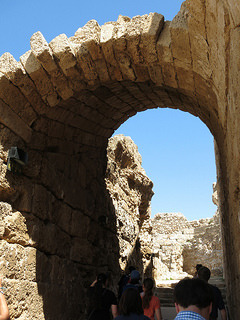 The vaults of the sky arched overhead.
The vaults of the sky arched overhead.
Beneath, men on scaffolding
tucked blocks of sandstone tight.
Once the keystone took its place
they hauled the wooden bolster free
and the stones stayed taut.
Pressure makes them motionless
even after two thousand years --
empire crumbled to dust, Iudaea
a forgotten name on mosaic maps.
Armies came and went, came
and went like the waves.
Today, tourists in Kelty hats
pose where chariots used to thunder.
The Slavic fishermen are gone,
their houses leveled and rebuilt.
Now a town on top of the ruins
of a town on top of the ruins.
A few kilometers away, lush green:
golfers stroll on manicured lawns.
Enough tension, nothing can shift
without bringing the whole place down.
Today's NaPoWriMo prompt invites the writing of poems featuring masonry. When I thought of stones and the laying thereof, I thought of how I'm drawn to photograph arches, and how very many of them I admired in my recent travels -- starting with the arch you see above, photographed on my first day after arrival. (If you're curious about those ruins, feel free to click through to my post about that day's journey: Walking in (ancient) Caesaria.)
Recent reading about Palestinians and Israel
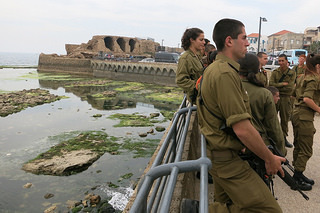 One of my Israeli friends on Facebook alerted me to a recent AP article: In West Bank, teen offenders face different fates. Here's how it begins:
One of my Israeli friends on Facebook alerted me to a recent AP article: In West Bank, teen offenders face different fates. Here's how it begins:
BEIT UMAR, West Bank (AP) - The boys were both 15, with the crackly voices and awkward peach fuzz of adolescence. They lived just a few minutes away from one another in the West Bank. And both were accused of throwing stones at vehicles, one day after the other.
But there was a crucial difference that helped to shape each boy's fate: One was Israeli, and the other Palestinian.
The tale of the two teens provides a stark example of the vast disparities of Israel's justice system in the West Bank, a contested area at the heart of the elusive search for a lasting peace.
It's worth reading, though I'll caution you that it's not a feel-good article; I think the picture it paints is pretty bleak. Still, as I've argued at some length, we for whom this piece of land is meaningful have an obligation to pay attention not only to what brings us pleasure there, but also to what saddens us.
Also interesting is Bradley Burston's latest in Ha'aretz, How to lie to college students about Israel (part one). He deftly skewers many of the untruths peddled by the Jewish right. (I'm really curious to see what he puts in the forthcoming companion piece, in which he promises to do the same for the Jewish left.) I particularly appreciate his point about the difference between boycotting settlement products and boycotting Israel writ large -- a distinction which I think is too often ignored in the American Jewish press.
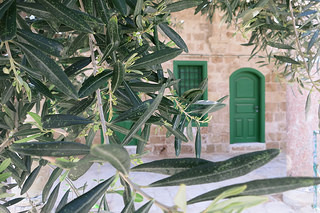 The final story I'll share is one which at least offers some hope: Palestinian Teaches Tolerance via Holocaust, in the New York Times:
The final story I'll share is one which at least offers some hope: Palestinian Teaches Tolerance via Holocaust, in the New York Times:
JERUSALEM — Mohammed S. Dajani Daoudi is an unlikely advocate for peace between Palestinians and Israelis. He trained as a guerrilla with the Palestine Liberation Organization, was banned from Israel for 25 years because of his prominent role in Yasir Arafat’s Fatah group, and still refers to Israelis as “my enemy.”
But Mr. Dajani, now the library director and a professor of American studies at Al-Quds University, in East Jerusalem, has become a prominent activist for tolerance...[and] in March he took what is thought to have been the first group of students from the Palestinian territories to visit the Auschwitz-Birkenau State Museum, in Poland.
Mr. Dajani has received some fairly predictable push-back from people in the Palestinian community who aren't fans of this sort of work. In response, he is quoted as saying:
My response to all this tirade is that my duty as a teacher is to teach, to have my students explore the unexplored, to open new horizons for my students, to guide my students out of the cave of perceptions and misperceptions to see the facts and the reality on the ground, to break the walls of silence, to demolish the fences of taboos, to swim against the tide in search of truth, in sum, to advance the knowledge and learning of my students in adhering to the verse in the Holy Quran, ‘And say My God increase my knowledge...’ If there are those who do not see or do not like that, it is their problem not mine.
(That latter quote comes from a Ha'aretz story: Palestinian professor who took students to Auschwitz responds to threats.)
Photos from my flickr stream: soldiers in Akko; olive tree and green door.
April 23, 2014
Daily April poem: instructions for drawing a map
MAP AND TERRITORY
Draw the lines firm: give no doubt
where the boundaries between us
and them. Your choice of alphabet
will locate you on one side
or the other. Think of the man
walking for seven years from where
the human story began. "I forget
the names of towns without rivers."
He wakes in the morning
to the footprints of desert beetles.
As we told the story of the Exodus
he took ship across the Red Sea
on a Syrian vessel full of mourners.
Hardboiled eggs rolled on their plates.
Will he climb the Harei Yehuda
or the Jibal al-Khalil?
Overhead, cranes following his route
chivvy him with rattling calls.
From their vantage his footsteps blur
into the sinuous tracks of a snake.
His path, the great rift
no negotiations can heal.
Luisa A. Igloria offered this prompt today:
Using couplets, write a poem of literal and metaphorical transplanting in the form of instructions for drawing a map.
In the poem, make reference to a specific mode of travel, a body of water, and a mountain range. Also include only the tracks or sound made by two types of animals that creep along the ground, and one that flies.
As I began the poem I had in mind my recent travels. Was I in Jerusalem or al-Quds? Judea and Samaria, or the West Bank, or Palestine?
That, in turn, reminded me of tweets I've seen recently about Silwan / the City of David from the team chronicling Paul Salopek's Out of Eden walk from Ethiopia to Tierra del Fuego. (If this is new to you, read about it -- it's extraordinary.)
The quote comes from one of Paul's recent dispatches, as does the image of the eggs rolling on the plates of Syrians aboard ship. That image particularly resonated with me because in Jewish tradition we eat hardboiled eggs (and also lentils) at the meal of consolation after a funeral. A reminder of life even in the face of death.
Edited to add: thanks to the team at Out of Eden for featuring this poem alongside a beautiful photograph from the crossing of the Red Sea on their blog: Couplets and Kilometers.
Daily April poem: à la New York school
NOT EXACTLY NEW YORK SCHOOL
It's the twenty-first of April (and
the same in Nisan, though
more than three thousand years separate
the Gregorian calendar from the Jewish one)
also the seventh day of Passover, sixth
day of the Omer, Patriot's Day though
only in Massachusetts, Marathon Monday
though only in Boston, city
of duck boats and blooming tulip magnolias,
Charlie cards and the neon CITGO sign,
where I first closed my eyes in rapture
over creamy North End cannoli,
hint of pistachio on the tip of my tongue.
What kind of New York School poem
mentions Boston? Do I betray
the cramped Lower East Side apartment
where my immigrant grandparents
settled with my mother, younger then
than my son is now? But they set out
for McKinney and Temple, Texas towns
not known for their bagels, though
in the big city of San Antonio
thirty years later someone would sell
"Shalom Y'all" trivets painted
in the Guadalajaran style. They missed
subways, pastrami piled on Jewish rye.
Me, I'd give my eyeteeth for a decent taco --
carnitas with fresh cilantro and red onion,
or Panchitos' chilaquiles with cheese
beside creamy refritos and fried potatoes
each perfectly crisp coin yielding
to pillowy interior -- though
I'm not sure what eyeteeth are, whether
I'd need them to eat the meal in question.
Some day like Wil Wheaton I'll tweet
"New York, I am in you" on my iPhone
and watch my son's eyes grow wide
at the sight of more cars and taxis
than he's ever imagined in his rural life.
But it's not my Jerusalem, the city
into which one ascends as though in a dream.
Even Jerusalem isn't my Jerusalem sometimes.
Am I the quintessential Diasporan, discontent?
No: give me a cat and a sunbeam, a few
crumbs from a Pesach almond cake
and a keyboard to write a poem on
and I'm happy as a clam at high tide --
a treif metaphor, odd from a rabbi
but I contain multitudes, like the crowds
lining the marathon route today
three hours to my east, in the city
of Irish pubs and Fenway, Boston strong.
Today's prompt at NaPoWriMo invited the writing of a poem in the style of the New York School of poets. They linked to Thom Donovan's recipe for doing so. His list features 23 items to consider including; I think I managed about half of them.
I'm a big fan of the New York School, ever since studying with David Lehman at Bennington (and reviewing his book The Last Avant-Garde, about the New York School, fof Pif) so I had a blast with this prompt.
Coming soon: Reb Zalman's glorious new translation of psalms
Many years ago I wrote a post about new translations of psalms, and one of the translations I referenced was from my teacher Rabbi Zalman Schachter-Shalomi, a.k.a. Reb Zalman. His creative, heartfelt, pray-able, earth-conscious renderings of psalms weren't published anywhere in print, but there was an audio cd available through the ALEPH store, and I loved hearing him speak the psalms in his own inimitable language.
Now, during the Omer this year, there's a project afoot to fund a print edition of Reb Zalman's renderings of the psalms. Here's a short video -- featuring, among others, Father Matthew Fox, Rabbi Sharon Brous, Brother David Steindl-Rast, and Pir Shabda Kahn -- reading his Psalm 100:
(If you can't see the embedded video, you can watch it at IndieGoGo or watch it at YouTube.) Here's a little bit about the project:
Published by ALEPH: Alliance for Jewish Renewal, Psalms in a Translation for Praying will be the definitive edition of Reb Zalman’s heart-felt translations for praying in English, developed and refined over decades. Newly edited, punctuated, and formatted for ease of use, the book will be a beautiful devotional companion.
Psycho-spiritually accurate for our age, this translation is gender-balanced (neither God nor God’s people are exclusively masculine or feminine) and understands that, in Reb Zalman’s words, “often [our] ‘enemies’ are not on the outside.” Although oriented to use in Jewish liturgy, care has been taken to ensure that Christians, Sufis and others can use this volume in prayer with ease.
I can't wait to pray from this volume. The hope is to publish it by Shavuot / Pentecost, the time when Jewish communities celebrate the revelation of Torah -- the yahrzeit (death-anniversary) of King David, to whom the psalms are traditionally attributed. I just donated to help fund the project. I hope you will, too: Reb Zalman's Heart-Psalms at IndieGoGo.
April 22, 2014
Daily April poem: about Elijah the prophet
ELIJAH WAITS
Elijah walks the streets
with Moshiach's phone number
programmed into his cellphone.
In his messenger bag
gift cards and cigarettes
he hands out to the homeless.
He always buys roses and gum
from the kids who peddle
at busy intersections.
He doesn't visit
every seder in the world
anymore. He still loves
the old melodies, the way
the story rewrites you
from the inside out if you let it
he finagles invitations
to the houses with great singing
and eager children, but
he's learned that our words
only matter so much.
When we box Pesach away
he holds his breath:
will we really emerge different
this time? Will we admit
we choose comfort over conscience
we cling to the neverending hametz
of our painful history --
or will we whistle Had Gadya
and recreate Mitzrayim?
Elijah sits back down
on the crumbling stoop
in the overcrowded hospital
at the enemy's table and waits.
Today's poem arose all on its own, without a prompt. It draws on some classical midrash about Elijah.
Had Gadya is a Passover song. Mitzrayim means Egypt, though it relates to the word root meaning narrow, so it can be rendered as "The Narrow Place."
April 20, 2014
Daily April poem: in a family member's voice
BRIDGE OF FLOWERS, EASTER MORNING
Because we had to hurry
to go through the river
and our bread fell off our backs.
I was an Israelite.
I love the daffodils best.
They're all growing.
That's what spring is.
Matzah is a kind of bread.
There's water on this side
of the bridge. And on
the other side too. I think
over there is a different river.
Today's prompt at NaPoWriMo invites us to write a poem in the voice of a family member. One of the suggestions they offer is one's four-year-old niece. I opted for the voice of our four-year-old son.
The first stanza contains his explanation of why we eat matzah at Passover. And we did actually walk over a bridge of flowers this morning.
Rachel Barenblat's Blog
- Rachel Barenblat's profile
- 6 followers









